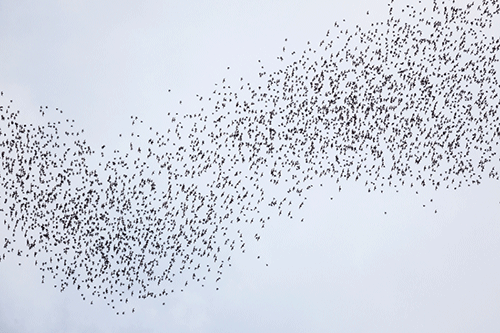Highlights from the Physics of Active Matter Conference
Bird flocks, fish schools, cell colonies, and other groups of self-propelled objects are all forms of active matter. At the Physics of Active Matter Conference in Suzhou, China, about 120 researchers gathered to discuss the latest achievements in this field. A focus of the discussions was the development of theoretical tools to describe active matter. These systems have striking similarities with liquids and gases, but they are different enough that new theories are needed to describe them. For some researchers, this is a chance to uncover new physics. Others hope that finding equations to describe active matter could lead to strategies for designing “smart” materials or to a better understanding of why certain animals travel in groups. Here is a selection of the research presented at the meeting.
–Katherine Wright
How Does a Wing Form?
When a fly reaches the end of its pupal stage, its cells undergo a dramatic reorganization to form the structures that become wings. Frank Jülicher at the Max Planck Insitute for the Physics of Complex Systems in Dresden has been studying the Drosophilia fly to understand how wing structure emerges from an initially uniform distribution of cells. Using a microscope, Jülicher imaged wings in vivo during the pupal stage, when cells are uniformly distributed in a fluid (the extracellular matrix) contained by a cuticle boundary. He observed a series of dynamic interactions between the cells that generated forces and flows through the fluid matrix: the cells divided, extruded, switched places, and pushed on each other until the wing took on its final structure.
To explain the experiments, Jülicher developed a model that describes the wing as a contracting elastic material in which the cells generate forces and respond to stresses from the wing’s outer surface. The interplay between the two determines the wing’s overall structure. His model could provide insight into how tissue properties emerge from the interactions between individual cells and could be used to quantitatively account for shape changes in other tissues during morphogenesis.
Does Active Matter Have an Equation of State?
Active matter systems are never in equilibrium because they consist of objects that constantly expend energy to move. But many systems do, at least qualitatively, resemble gases. This similarity has inspired researchers to use thermodynamic tools to find general equations that describe the behavior of active matter systems in terms of their bulk properties. At the meeting, Julien Tailleur of Diderot University in Paris discussed his efforts to find an equation of state to describe one of the simplest active matter systems: a gas of self-propelled particles in a container.
Tailleur derived an equation that relates the pressure the particles exert on the container walls to their speed, ability to reorient, and their interactions with each other. He found that there is no general pressure law for the self-propelled particles; instead, the pressure is system specific and depends on the precise interactions between the moving particles and the wall of the container. (An exception is spherical particles, as discussed in this Viewpoint). Is this a blow to finding a general equation of state for active matter? Not necessarily, said Tailleur. Rather, it might indicate that new concepts, beyond mechanical pressure and other quantities associated with thermodynamic equilibrium, are needed to describe these systems.
Cell Colonies Behave Like Liquids
Cell colonies such as animal tissue often grow in confined geometries. Researchers want to measure the bulk mechanical properties of these colonies because they can reveal the microscopic interactions between individual cells, which are often hard to determine directly. Cristina Marchetti at Syracuse University in New York presented her theoretical study of a cell colony in which she can vary the forces between cells, and between the cells and an underlying surface.
In Marchetti’s model, static cell colonies form when the individual cells aren’t motile and the cells strongly adhere to the surface. In this case the colony looks and behaves like a liquid drop that wets a surface, with interactions between the cells holding the whole colony together. In contrast, colonies of motile cells, in which the propulsion forces dominate over surface adhesion, can migrate as they grow. These colonies behave like a “non-Newtonian” liquid: they can flow around objects, but they are also elastic. And under certain conditions the elastic-fluid-like colony transmits mechanical waves. Marchetti’s results suggest that individual cell activity and migration help the colony to assemble and move. Understanding how and why these different confined colonies form could allow researchers to control cell migration and assembly, which would, for example, be important for engineering tissues.





